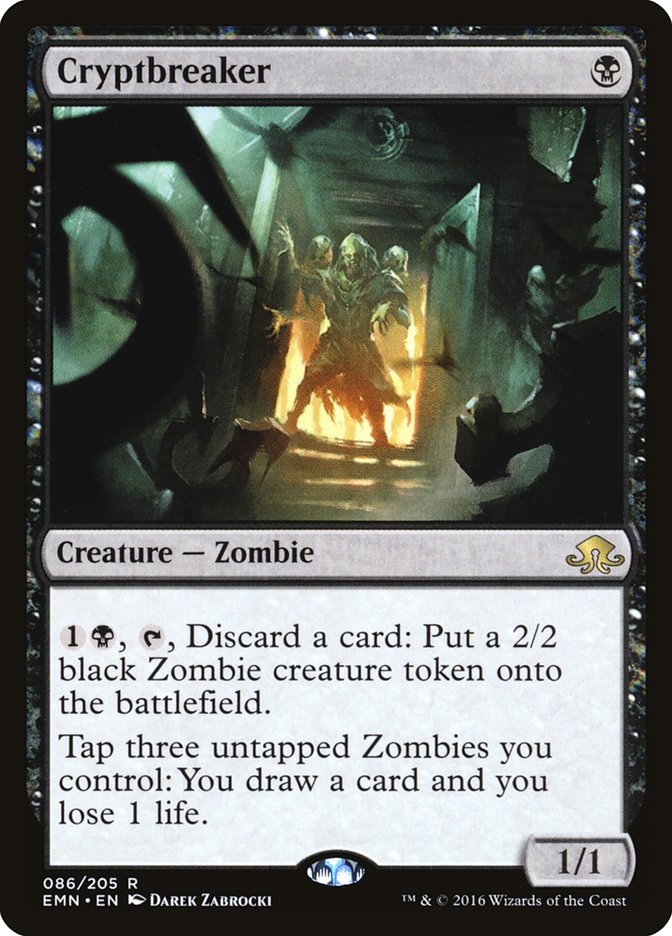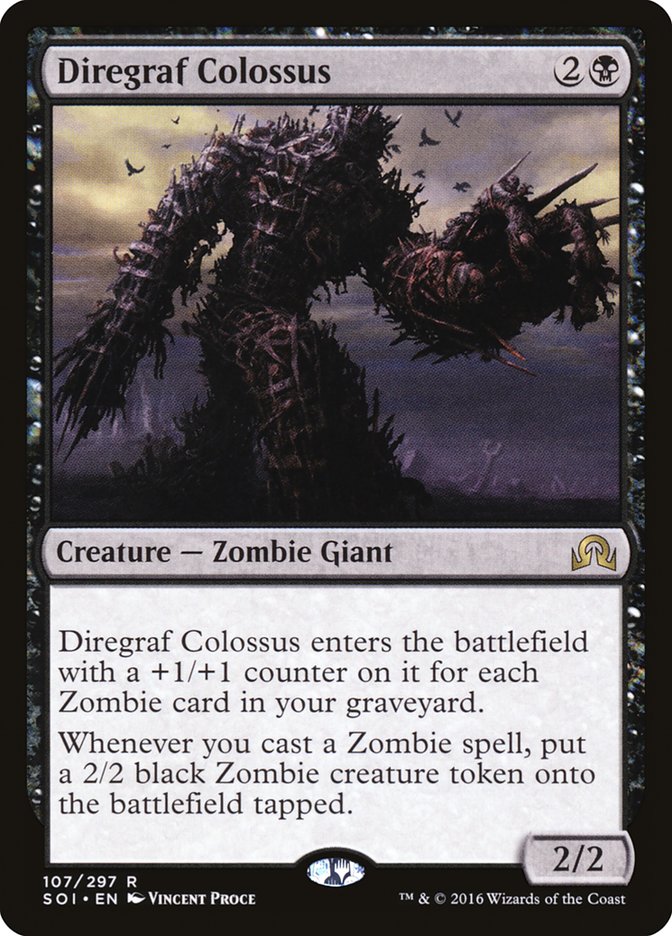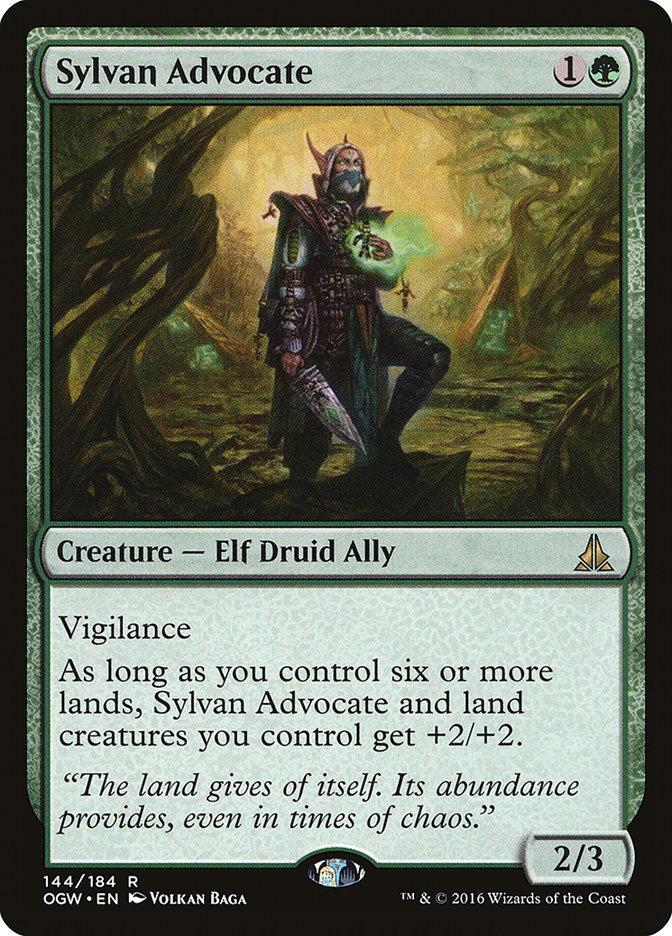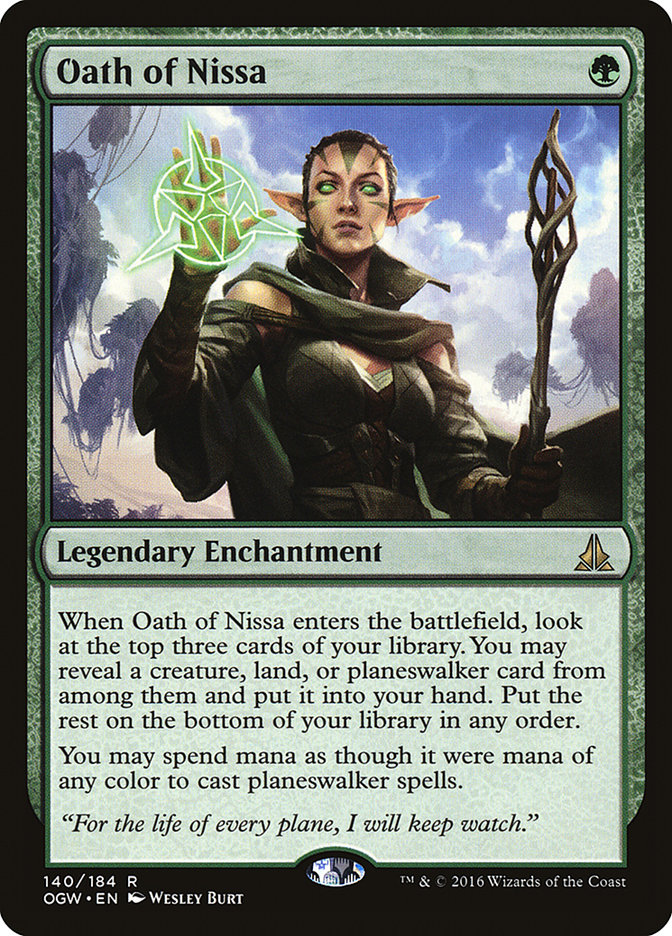A man called Bard lived with many friends up in the mountains of Virginia. His friends, like him, were Magic players. Everyone took turns claiming they were the best, or they broke the format, but not Bard. Accomplished enough to earn the trust of his peers, Bard was too self-doubting. He found it very tiresome to make bold claims he was unsure of. Time after time Bard sold himself short. His friends would believe him until seeing his prowess firsthand. Many would ask Bard why he would say such untrue things, but he never had an answer.
One day, just like any other, Bard was unsure of his deck choice. His statement was met with disapproval, as all his friends didn’t believe him. They ignored his affirmation, and ventured onward with his technology. Later that day they had all been defeated, yet Bard ventured on. Frustrated, they stomped up to Bard to accost him for their actions. Perplexed by this outrage, Bard could only shrug.
You see, the moral of this story isn’t that of crying wolf. Doing well and having confidence are not mutually exclusive. Some would even say that a lack of confidence is what keeps competitors striving for every edge they can obtain. Bard doesn’t say these statements of uncertainty as a ploy, but simply never wants to become complacent. It’s your job when following in Bard’s footsteps to also put effort into respecting his process, and not just his lists.
Oh, what a day, what a lovely day! For as long as I can remember my brother Corey, and I have dreamed of participating in the single-elimination rounds of a professional event together. It almost even happened in 2015 when we both were going to have “win-and-ins” in Round 15 of Grand Prix Miami. In a disappointing turn of events, we ended up paired against one another. At the beginning of this year, we had another opportunity at Grand Prix New Jersey, but I didn’t hold up my end of the bargain, losing out late into Day 2. Finally, after eight years of playing this game competitively, we finally did it. We finally got to do the “eagle!”

Nowm I’d love to go on and on about how awesome my brother is, but that’s not going to help you qualify for the Pro Tour. Today we are going to get into the nitty-gritty of Standard, and discuss B/G Constrictor, starting with why I decided to play the deck at Grand Prix Minneapolis.
It all began on a warm summer’s day in Roanoke, VA. I’d just gotten back from Japan and was rather burnt out from playing Magic. That said, I had a tournament coming up, and I’d learned a long time ago that if you’re going to do a job, it might as well be done right. I grabbed my computer, and began decompressing everything I thought I knew about the Standard format.
The first place I, and most likely everyone else, went was figuring out what impact Ramunap Red would have on the format. It was clearly the deck of Pro Tour Hour of Devastation, but would that translate into dominating the format? Sure, Ramunap Red is a great deck, given how well it mitigates flood and how it has more reach than any red deck in recent memory, but it’s still a linear aggressive deck. Odds are that people will be prepared for the deck, making it nearly impossible to consistently navigate it to a good finish. I knew for this reason alone I wouldn’t want to play the deck again.
I picked up Team MTG Mint’s Mono-Black Zombies list and played around with that. Resilient, consistent, but underpowered and rigid. Mono-Black Zombies is a great deck, but it’s just too inflexible for me. I like to be able to make more decisions on a turn-to-turn basis than the deck can provide. Powerful, of course, but just not my cup of tea, even though I’ve tried it so many times.
Next up on my list was Sam Pardee’s B/G Delirium build. I love me a Tireless Tracker more than life itself, but playing this deck didn’t make me feel good about the strategy. Both Grim Flayer and Tireless Tracker felt outdated, rustic. In days past their abilities had more impact on a game, but right now things are just too fast-paced for their slowed-down country ways. I started talking with Sam Pardee about the deck, and he had similar concerns. He suggested trying Sylvan Advocate, and I did just that. Sylvan Advocate gets around Shock, but also can attack and block against Ramunap Red. This can be crucial when it comes to beating the deck, as you have to put some pressure on them in the early turns so they can’t just clog the battlefield up and burn you out.
Sylvan Advocate was just great, but I still disliked the rest of the Delirium package. Oddly enough there wasn’t much of it left in the deck, but still Evolving Wilds and Traverse the Ulvenwald felt too slow, not just against Ramunap Red but other decks as well. Traverse the Ulvenwald was great in the mirrors, but outside of that, it often felt like it cost me more games than it won.
Traverse isn’t even that good against the “combo” decks of the format like G/R Ramp or U/W God-Pharaoh’s Gift. The best way to defeat these decks with B/G Constrictor is to go for the throat and curve out. Traverse the Ulvenwald is too slow to get online against them, and even then searching for creatures rarely will get you out of a bad situation. Relying on spells is the name of the game against them, anyway.
I did some research, and decided to take a stab at the most outdated variant of B/G Constrictor.
Creatures (21)
- 2 Catacomb Sifter
- 4 Sylvan Advocate
- 4 Verdurous Gearhulk
- 4 Winding Constrictor
- 3 Rishkar, Peema Renegade
- 4 Walking Ballista
Planeswalkers (3)
Lands (24)
Spells (12)

Oath of Nissa has become a forgotten card in B/G Constrictor for some time now. This variant was starting to pick up velocity but almost immediately got sideswiped by Four-Color Saheeli. Quickly forgotten, B/G Constrictor had to constantly adapt to defeat the combo energy variants that began to take over Standard. Finally, with Ramunap Red running the show, this variant of B/G could possibly come back. Someone just had to give it a try.
My initial results with the deck were better than anything else I tried, but still nothing special. My brother Corey Baumeister and teammate Seth Manfield both gave the deck a shot, though, and really liked it. Both smashed their first League with the deck and locked it in. I was forced to find something better with limited time, or do the same. In the end I took the path of least resistance and jumped on the bandwagon with them.
The advantages to playing Oath of Nissa are simple. You want to make sure you function as well as possible in the first turns of the game. Traverse the Ulvenwald variants will be better against you, but Oath of Nissa is what you’re looking for when faced with matchups like Ramunap Red, Mono-Black Zombies, U/W God-Pharaoh’s Gift, and G/R Ramp. That’s because Oath of Nissa facilitates early-game consistency and explosive mid-games. B/G Constrictor has many synergies built into it, and finding cards that combo together can help the deck when you get to four to five mana. They’re not great in the late-game compared to Traverse the Ulvenwald, but there’s no guarantee you’re getting that far anyway.
Second, trimming lands right now isn’t a good idea. Magic’s sped up greatly thanks to eight-set Standard, which means you rarely want to take the time off play Traverse the Ulvenwald for a land. At the same time, you’ll want to play Evolving Wilds, which just adds to the deck’s sluggishness. Making your first five land drops on time and having them untapped is crucial right now for any deck. Even after sideboarding, there are cards in each deck that may go unanswered. Since we aren’t interacting with everything our opponents bring to the table, games won’t be slowing down as much as if we were killing all of each other’s stuff. Curving is by far the most vital aspect of Standard Magic right now.
We don’t even have to single out Traverse the Ulvenwald here. Attune with Aether is played in B/G Energy to help support Longtusk Cub and Glint-Sleeve Siphoner. Both great cards, but not really what I’m looking for against this specific metagame. Maybe if things shift around, but for now I’d rather my creatures have three toughness, or interact well with Nissa, Voice of Zendikar better than these two do. They are just not better enough than current options to justify playing such a low land count.
That’s why it’s easy for me to suggest this variant of B/G Constrictor moving forward. Normally I’m more timid suggesting a deck to players looking for a well-educated suggestion for their Pro Tour qualifying events. I know this run of RTPQs is very important for many players out there, which is why I don’t take articles around this time lightly. I want these words to help players on their journey to the Pro Tour. With all of that said, this is the list I’m suggesting for this weekend.
Creatures (20)
- 3 Catacomb Sifter
- 4 Sylvan Advocate
- 3 Verdurous Gearhulk
- 4 Winding Constrictor
- 2 Rishkar, Peema Renegade
- 4 Walking Ballista
Planeswalkers (4)
Lands (24)
Spells (12)

The first thing you may notice about this list is that the maindeck is the same as the one I played at Grand Prix Minneapolis. I for one was happy with it, and see no reason to change it. I toyed around with a single Aethersphere Harvester, Dissenter’s Deliverance, or Kalitas, Traitor of Ghet, but never really liked them. They were just too high-variance for me. Each card has pros and cons I could get into, but to me, that would be a waste of time right now. If you like those cards, just play a miser’s copy. Changing the list by a single card won’t really have that significant of an impact on your results. In fact, I encourage changing the deck ever so slightly to lessen the information your opponents have about your exact deck configuration.
Now, as we move into discussing the sideboard, I want to bring to light something unusual about it. Outside of Skysovereign, Consul Flagship, there are no proactive elements. Now, that’s pretty unusual in general, but especially strange for me to suggest when you take into consideration the way I normally like to build a sideboard.
B/G Constrictor decks are based around the synergies provided by all of their nonland permanents. The more you have in play, the better they all can function. When operational, they are far more powerful than anything else in the format. You really don’t need to change them up, since the ones you leave in the deck will effectively get weaker sometimes depending on what you do.
The other, more important reason for this is that everyone’s doing it right now. Now, before you go calling me a hipster, hear me out! Almost every deck’s sideboard is littered with differing threats they will bring in depending on what matchup they are in. They all transition in some way so that their threats line up better against their opponent’s removal. When that’s the case, you need to focus more on making your removal line up with their threats, especially when one of your strongest cards is a planeswalker you’re trying to protect.
Now that we’ve covered that, let’s talk about the matchups a little bit.
Creatures (23)
- 4 Falkenrath Gorger
- 4 Bomat Courier
- 2 Kari Zev, Skyship Raider
- 3 Hazoret the Fervent
- 4 Ahn-Crop Crasher
- 2 Soul-Scar Mage
- 4 Earthshaker Khenra
Planeswalkers (2)
Lands (23)
Spells (12)

The existence of this deck is the main reason why I went to this variation of B/G Constrictor. Awkwardly enough, I took a Round 5 draw at Grand Prix Minneapolis and thus never played the matchup until the Top 8, where I lost to it. Who said life’s not funny!
You need to be proactive in this matchup. Now that doesn’t mean aggressive. Don’t trade damage when you don’t have to, but be sure to prioritize getting on the battlefield. Sylvan Advocate helps out immensely here as it can play offense and defense, allowing you to get in an early six to eight points of damage when it stays alive. This is important because Ramunap Red does have a ton of reach, so a racing situation may happen whether you like it or not.
Now Ramunap Red has to diversify its threats against you after sideboard. Cards like Chandra, Torch of Defiance, and Glorybringer should be expected. They will be forced to take out some of their early-game creatures and Shocks to facilitate this. Don’t go crazy when sideboarding this matchup. Less is more here, as you want to present some pressure against them. I normally take out a couple of Fatal Pushes on the play for removal that hits their bigger threats, and that’s about it. On the draw, I don’t even know if it’s correct to sideboard at all.
Creatures (23)
- 3 Kalitas, Traitor of Ghet
- 4 Relentless Dead
- 4 Diregraf Colossus
- 4 Cryptbreaker
- 4 Lord of the Accursed
- 4 Dread Wanderer
Lands (24)
Spells (13)

This matchup is close. Close enough to add a Liliana’s Defeat to the sideboard if you want to, as it’s a significant upgrade to Fatal Push. I don’t think the card is better than Yahenni’s Expertise, though. This matchup is all about who gains more inherent card advantage, and you are desperately behind in outlets. That said, you’re the more powerful deck when the engines are revving. That’s the trade-off and why everyone believes Mono-Black Zombies to have the advantage in the matchup. It’s just the better-looking deck when it’s winning.
The goal is to lean on Nissa, Voice of Zendikar. Think of this card as your queen on a chessboard. The more maneuverability she has, the better chance you have of victory. She can play defense well as she ticks up to ultimate, or offense when she’s distributing more dice than you brought with you. When she’s on the battlefield, the games are on easy mode. Protect her at all costs. At all costs!
This means sometimes you won’t just want to slam her on the table. She can combo with a Winding Constrictor on turn 5 to help you catch up against a Liliana’s Mastery. Often that’s the path to victory you never saw as you put those cards on the battlefield earlier, just to watch them get killed. Sequencing is complicated in this matchup but can’t be taught in an article. You have to get in the reps if you expect to win this matchup consistently.
Sideboarding
Out:
In:
I’ll often shave an Oath of Nissa when I bring in removal over some of my nonland permanents. Just wanted to get that out there. After that, I’m confident in my inclusions, but still a little wary about what creatures to take out. I’d suggest toying around with them to see what you think yourself, but for the most part, this sideboarding is fine. The only thing to keep in mind when playing games after sideboarding is that you don’t need to kill every creature they cast, thanks to Yahenni’s Expertise, but they also know what’s up when you do this. Thankfully, a Nissa, Voice of Zendikar on the table forces their hand. Like I said, she’s the queen!
Creatures (20)
- 2 Kalitas, Traitor of Ghet
- 3 Tireless Tracker
- 1 Ishkanah, Grafwidow
- 4 Grim Flayer
- 1 Verdurous Gearhulk
- 4 Winding Constrictor
- 1 Rishkar, Peema Renegade
- 4 Walking Ballista
Planeswalkers (5)
Lands (23)
Spells (12)

The B/G Constrictor “mirrors” play out in a magnitude of ways. Sometimes someone can’t kill their opponent’s first couple of threats and dies a quick death due to being second to the battlefield. Other times, everything’s dying and Nissa, Voice of Zendikar rules the roost. Then there are those games where nothing seems to click for either player, and whoever draws Verdurous Gearhulk first just smashes the opposition. There really isn’t a way to play the matchup correctly. Being good at Magic helps sometimes.
Sideboarding
Out:
In:
First of all, this is by far the weakest your deck can be built for B/G “mirrors.” If you expect to play against more of them, you have to replace cards like Dissenter’s Deliverance with Gonti, Lord of Luxury or Tireless Tracker or, I don’t know, play Traverse the Ulvenwald builds. I’ve already expressed why I’m not running these cards due to how the format currently works.
I’m also saying this from my ivory tower. I don’t have to play RPTQs this weekend. I don’t know your metagame. I don’t know your strengths, weaknesses, thoughts, or fears. If you want my advice, bring a couple of extra Gonti, Lord of Luxury with you and survey the field in the morning. If you get the impression that Mardu, Zombies, and U/R Control are more prominent than B/G, play this build. If you see a lot of this deck, I would likely cut one Dissenter’s Deliverance for a Gonti, Lord of Luxury and then contemplate if I play the second copy.
That said, I do feel like many B/G players will be on equal footing this weekend. One or two cards won’t make much of a difference given how volatile the matchup is, which bodes well for you if you play this 75. It takes a lot of cards to truly swing the matchup into someone’s favor, and any build with that much for the mirror is assuredly garbage against the field.
Creatures (24)
- 4 Bygone Bishop
- 4 Thraben Inspector
- 4 Hanweir Militia Captain
- 4 Spell Queller
- 4 Selfless Spirit
- 4 Cloudblazer
Lands (25)
Spells (11)

They have the advantage Game 1, and in all honesty after sideboarding thanks to Dusk // Dawn. Both sides can be backbreaking, so doing your best to play around this card is important. That said, Walking Ballista is the best card in the matchup and can win the game all by itself. Games will play out very differently depending on who is on the play, if they cast Oketra’s Monument, or if you had a strong start. It’s highly suggested that without a Walking Ballista you should just go all-in and hope they don’t have Dusk // Dawn. That’s because they can assemble five creatures and Westvale Abbey very easily and close out the game. With a Walking Ballista, you can sometimes pick your spots more easily.
Sideboarding
Out:
In:
After sideboarding, you can more easily deal with Oketra’s Monument but also take a Dusk // Dawn out of their hand the same turn you pump it up. They don’t really change much, but expect a few Angel of Sanctions to disrupt your Walking Ballistas.
Creatures (4)
Lands (25)
Spells (31)
- 4 Magma Spray
- 2 Essence Scatter
- 4 Harnessed Lightning
- 4 Glimmer of Genius
- 4 Disallow
- 4 Censor
- 3 Hieroglyphic Illumination
- 2 Sweltering Suns
- 3 Abrade
- 1 Hour of Devastation
Sideboard

Ugh. I hate this deck. You know it already, so I won’t get into it. You have all this stupid removal Game 1. If you draw it, you die. If you don’t, they probably die. They can also draw badly, and you win anyway. I’m sick of this deck.
Sideboarding
Out:
In:
Games are much better after sideboarding. You now have less bad removal, and more good ones to take down their threats. On top of that, you can strip that pesky Torrential Gearhulk out of there deck. Let’s see them beat you without them!
(I lost to Saito at the Grand Prix after taking his Gearhulks…)
The list of decks goes on and on. Some of them are good matchups, while others are bad. Hopefully you had enough practice with the deck by this weekend to at least be able to sideboard in these matchups. There are just too many interactions between the lists to be able to give a concrete sideboard guide for them. Also, hopefully, you just play against the decks on this list, as those are the ones you’re prepared to beat. I hope you get there this weekend, and please let me know if you did it thanks to my help. Or if you did the opposite and it was successful. Regardless, I had something to do with it!
Now go, and get those qualifications!







